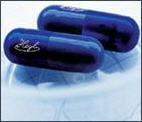Prussian Blue Is Used to Treat Exposure to Which of the Following

Prussian Blue, Insoluble (Radiogardase®)
- Indications and Usage
- Reference Links
- Prussian Blue information sheet for the general public (HHS/CDC)
- How to Get?
Indications and Usage
- This oral ion-exchange drug is indicated for decorporation of cesium and thallium and has been shown to be highly effective for Cs-137 contamination.
- Prussian blue is not FDA approved for rubidium.
- It is benign, with the exception of occasional constipation.
- Prussian blue turns the stool color blue.
- Marketed as 0.5 gram (500 mg) insoluble Prussian blue in gelatin capsules for oral administration.
- Prussian blue is available only by prescription.
- PO Dosing
- Adults (Two adult recommended dosing regimens exist.)
- From Goiânia accident data (PDF - 6.4 MB):
- 1-3 grams (2-6 capsules) PO tid
- Usual dose starts at 1 g (2 capsules) PO tid for up to 3 weeks (or longer, as required).
- Doses up to 10-12 g/day for more significantly contaminated adults may be used
- FDA drug label (PDF - 208 KB): 3 g (6 capsules) PO tid
- From Goiânia accident data (PDF - 6.4 MB):
- Children 2-12 years old
- FDA drug label (PDF - 208 KB): 1 g (2 capsules) PO tid. Capsules may be opened and mixed with food.
- Children <2 years old
- CAUTION: Use has not been approved by the FDA. However, during a mass casualty emergency, medical leaders may activate an EUA for how to use Prussian Blue from the SNS in children under 2 years of age.
- Duration of treatment
- Typically, a minimum of a 30 day course has been recommended, but clinical and availability conditions may alter this recommendation.
- It is useful to obtain bioassay and whole body counting to assess treatment efficacy.
- Duration of therapy depends on total body burden and response to treatment.
- The HHS/ASPR, which manages the SNS, has included Prussian blue in the Strategic National Stockpile (SNS), a special collection of drugs and medical supplies that HHS/ASPR keeps to treat people in an emergency.
- Other names for Prussian blue:
- Berlin blue
- Ferric ferrocyanide
- Ferric(III) hexacyanoferrate
- Ferric hexacyanoferrate (II)
- Iron blue
- Radiogardase-Cs
- Fe4[Fe(Cn6)]3
top of page
Reference Links
CDC resources
- Facts about Prussian Blue
- Prussian Blue Fact Sheet (PDF - 79 KB)
- Prussian Blue: Introductory Information (YouTube: 2:48 minutes)

FDA resources
- Drug label for Prussian blue (Radiogardase) (PDF - 207 KB)
- Prussian Blue: Approved Dosing for Children (PDF - 207 KB) (page 7)
- FDA Approves First New Drug Application for Treatment of Radiation Contamination due to Cesium or Thallium (2003)
Other
- Prussian Blue (Radiogardase) (YouTube: 2:20 minutes) (DOE/ORISE/REAC/TS)

- Use of Prussian Blue (Ferric Hexacyanoferrate) for Decorporation of Radiocesium (Public Health England [PHE], formerly Health Protection Agency [HPA], December 2010)
- Rump A, Stricklin D, Lamkowski A, Eder S, Port M. Benefit-Cost Analysis of Radiocesium Decorporation by a Prussian Blue Treatment and Stockpiling. Drug Res (Stuttg). 2018 Feb;68(2):89-99. [PubMed Citation]
top of page
How to Get?
- Prussian blue is available only by prescription.
- Strategic National Stockpile
- How to get prussian blue in US
- See information provided by REAC/TS
top of page
References
- Dose assessment of inhaled radionuclides in emergency situations (Public Health England [PHE], formerly Health Protection Agency [HPA]/United Kingdom and Treatment Initiatives After Radiological Accidents (TIARA) Project/European Commission, August 2007)
- Management of Persons Contaminated With Radionuclides: Handbook (NCRP Report No. 161, Vol. I), National Council on Radiation Protection and Measurements, Bethesda, MD, 2008, Decorporation Therapy by Drug (pp. 201-209). [Note: NCRP 161 supersedes NCRP 65.]
- Management of Persons Contaminated with Radionuclides: Scientific and Technical Bases (NCRP Report No. 161, Vol. II), National Council on Radiation Protection and Measurements, Bethesda, MD, 2010, Appendix H.3 Goiânia Incident (pp. 908-915).
- Uncertainties in Internal Radiation Dose Assessment (NCRP Report No. 164), National Council on Radiation Protection and Measurements, Bethesda, MD, 2009.
- Cesium-137 in the Environment: Radioecology and Approaches to Assessment and Management, (NCRP Report No. 154), National Council on Radiation Protection and Measurements, Bethesda, MD, 2006.
- Adults (Two adult recommended dosing regimens exist.)
Source: https://remm.hhs.gov/prussianblue.htm
0 Response to "Prussian Blue Is Used to Treat Exposure to Which of the Following"
Post a Comment